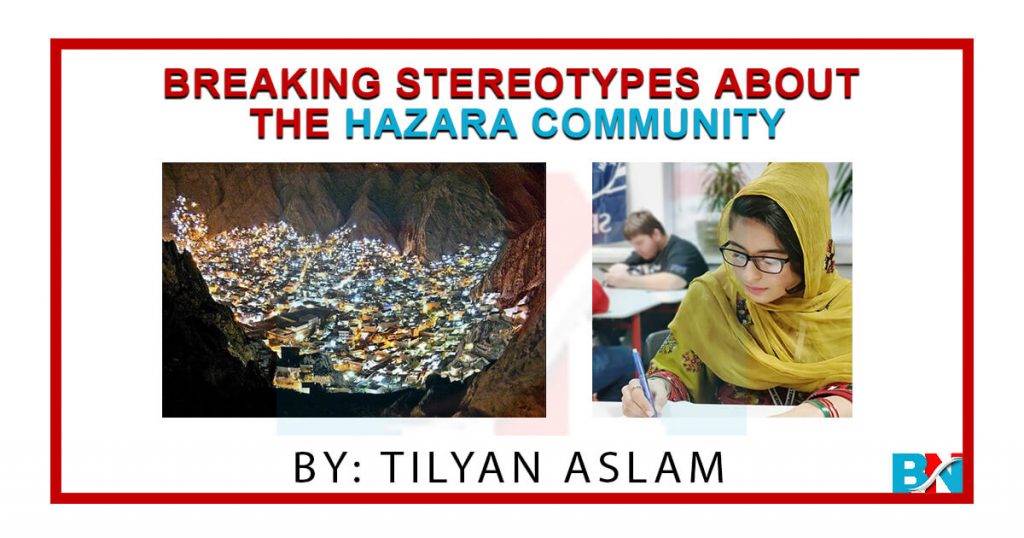When you think of the Hazara community, possibly the first thing that pops up on your mind is, “Hazaras don’t like anyone except those in their own community” or “they are very rude and mean” or “they might attack anyone anytime” or more generally things like “Hazara people are very conservative and unprogressive.”
The list of misconceptions people have about the Hazara community goes on without actually knowing anything about them properly neither with personal proximity nor with facts and figures, but only with rumors and tittle-tattle.
Hazaras are a Persian-speaking ethnic group essentially living in Hazarajat, in central Afghanistan. In Pakistan, most of the Hazaras predominantly live in Quetta. The entire population of Hazaras in Pakistan is between 600,000 to 1 million, majority of them are Shia muslim, a few might be Ismaili with others being sunni Muslim.
In Quetta, the Hazara community mostly lives in two areas; Hazara town and Mariabad (Alamdar road). These two places are their only homes in the city where they have settled and made their own community with peace and harmony. What’s most amazing about this community is their unanimity and togetherness they have built up with each other.
I have always been eager to know and learn about different cultures and religions, but what actually made me explore and dive into this beautiful community was my first visit to Hazara town, in Quetta. Along with a friend, I walked into this peaceful place just to know how this community lives, away and different from the normal lives in Quetta. I have already had a few Hazara friends, but during this time, I made another friend who tour guided us about their entire community and their lifestyle.
As Wendell Willkie said, “ There are no distant places any longer: the world is small and the world is one.”
In the same way, when we learn about the similarities between different communities, we become empowered and humbled.
To me, exploring Hazara town was like finding a new Quetta. This little community had so much to serve us – peaceful and clean streets to walk by, very warm and welcoming people to talk with, affordable stuffs to buy and yummy dishes to try.
Manto – is a traditional and very special dish served in the restaurants and food points of the Hazaras. It is basically a meat-stuffed dumplings of either beef or lamb mixed with minced onions and spices and steamed in a multilayer steamer. Hazara Town had a pretty affordable mall to visit namely MDM – Muhammad Dawood Mall where the entire community rushes in the evening to enjoy with friends and family. The staff in the mall was so kind that I couldn’t resist, but had to visit this place more than four times.
Apart from that, one thing that really stood to me throughout my journey was women being able to work as shopkeepers, saleswomen, waiter and even owners. That was one of the best ways of seeing how supportive and progressive the entire community is. The stereotype I had about them being conservative and rude was all cleared up by the time I left for home because the way I could see people walking freely and being warm and welcoming was something really touching to me as a Baloch girl visiting this whole new different place.
Moreover, Mari Abad is another home for the Hazaras in Quetta. It is an inner eastern suburb of the city. The most fascinating thing about this place is the houses made on the mountaintop. The view of this place at night is really enthralling to see.
After experiencing how hospitable people in Hazara town are, my eagerness to visit Mari Abad was even more so I decided to explore this part of the city too. Mari Abad has a lot more history compared to Hazara town since they have Ziarat e Koh, Alamdar Road, famous Eid Gahs and Dams in Mari Abad where one can witness some really breathtaking views of this site.
To be very genuine, what actually caught my eye was the bazar of Mari Abad – Jannat Gali (very unique in name) that reminded me of the busy streets of Chandni Chowk of Delhi – full of lights and life. I also got a chance to try another dish of this community – Ashhak, which is a dish similar to Manto, but filled with chives, tomato sauce and has a topping of yogurt and dried mint.
It will not be an exaggeration to say that the place, the people and the warmth in these sites have a very soft spot in my heart. Hazaras’ are no doubt, one of the most civilized, educated and organized people, I have encountered in my life so far.
After meeting with so many of Hazaras’ in just a short span of time, all I can conclude is; before we make an assumption about people who are different from us, we should atleast figure out ways to learn from and about them. That’s how we seek knowledge and have an understanding of the differences of others.
As it is beautifully said, “ In diversity there is beauty and there is strength and we must continue to appreciate the vibrancy of diversity without fracturing our communities.”


